|
Jellyfish are not really fish. They are related to sea anenomes and sponges.
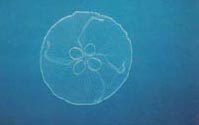
Moon Jelly
photo by Bernd Mock,
Beneath the Seas of the West Indies, p.
58
Jellies and sea anenomes have a simple nervous system and a mouth surrounded by
tentacles. The tentacles contain unique stinging cells called cnidocytes..
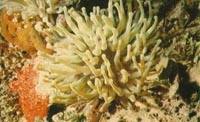
Sea Anenome
photo by Bernd Mock,
Beneath the Seas of the West Indies, p. 25
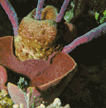
Sponges
photo by Bernd Mock,
Beneath the Seas of the West Indies, p. 50
|
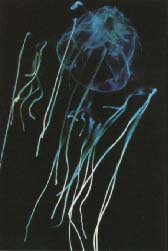
Box Jelly
photo by Keith Gillett,
A Medical Guide to Hazardous Marine Life, p. 27
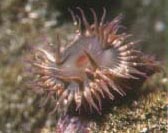
Sea Anenome
photo by Paul Auerbach,
A Medical Guide to Hazardous Marine Life, p. 27
Sponges
are the simplest of all animals. They have no tissues or organs. Their bodies are made
of two layers of cells separated by a jelly-like layer. Water moves through tiny
openings in their bodies, bringing in food particles
|
| What You Should Do for Jellyfish and Sea Anenome Stings
If you are stung by a jellyfish or come in contact with a sea anenome, follow these steps:
1. Immediately rinse your skin with sea water. Do NOT rinse with fresh water. Do NOT apply ice.
Do NOT rub the skin.
2. Make a solution that contains 95% water and 5% vinegar and soak the injured area until the
pain is lessened.
3. If vinegar is not available, you can use isopropyl alcohol (40% to 70%). However, vinegar is
much better for Australian box jellyfish.
If vinegar or alcohol are not available, briefly cover
the sting with a paste of baking soda, or unseasoned meat tenderizer, or mashed papaya, or urine.
You should not use meat tenderizer for longer than 10 minutes on the skin of children. An ice pack
may help ease the pain, as long as no water is leaking from the pack.
|
What to Do About Sea Sponge Irritations
1. Soak the skin with a solution that is 5% vinegar and 95% water for 10 to 15 minutes by wetting a
gauze pad or cloth with vinegar and placing it on your skin. Then dry your skin.
2. Put the sticky side of adhesive tape on the skin and peel off the tape. This will remove most
sponge spicules (small needle-like pieces).
3. Repeat the vinegar soak for 5 minutes.
4. If the pain is severe or if the rash worsens or shows signs of infection, your doctor may
prescribe medicine to relieve the pain, itching or infection.
|

